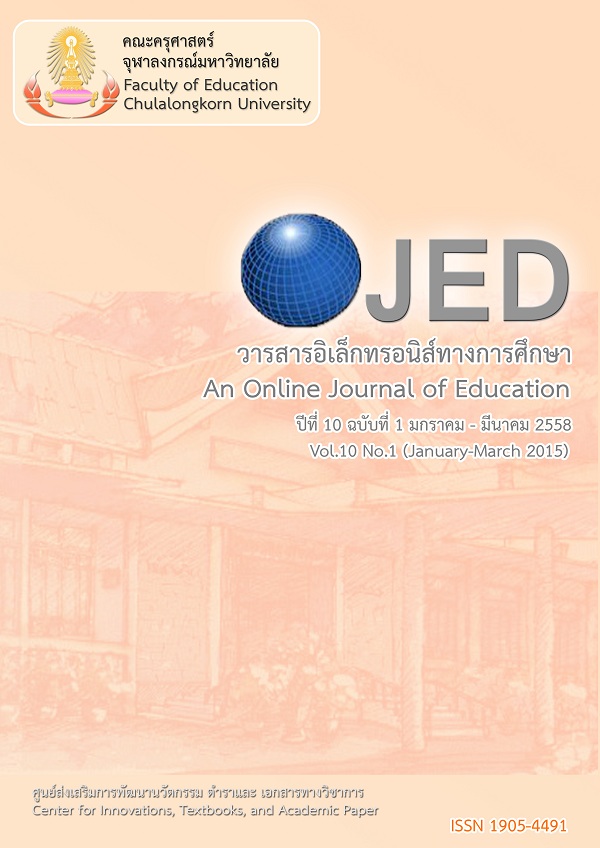การศึกษาการบูรณาการเนื้อหาด้านวัฒนธรรมของเจ้าของภาษาของครูไทยในการสอนภาษาอังกฤษ
Keywords:
เนื้อหาด้านวัฒนธรรมของเจ้าของภาษา / การบูรณาการวัฒนธรรมของเจ้าของภาษาในการสอนภาษาอังกฤษ / ครูไทยผู้สอนวิชาภาษาอังกฤษ/NATIVE SPEAKERS' CULTURAL CONTENTS / INTEGRATING NATIVE SPEAKERS' CULTURE IN ELT / THAI ENGLISH LANGUAGE TEACHERSAbstract
การวิจัยครั้งนี้มีวัตถุประสงค์เพื่อ 1) ศึกษาการบูรณาการเนื้อหาด้านวัฒนธรรมของเจ้าของภาษาที่ครูไทยบูรณาการในการสอนภาษาอังกฤษและ 2) ศึกษาความเห็นของครูไทยที่มีต่อความสำคัญในการบูรณาการวัฒนธรรมของเจ้าของภาษาในการสอนภาษาอังกฤษ กลุ่มตัวอย่างประกอบด้วยครูผู้สอนวิชาภาษาอังกฤษชั้นมัธยมศึกษาจำนวน 30 คน จากสองโรงเรียนในเขตพื้นที่การศึกษามัธยมศึกษา เขตสอง เครื่องมือที่ใช้ในการวิจัยประกอบด้วยแบบสอบถามและการสัมภาษณ์กึ่งโครงสร้าง ผลของการวิจัยพบว่า เนื้อหาด้านวัฒนธรรมที่ครูนำมาบูรณาการมากที่สุด ได้แก่ การใช้ชีวิตประจำวัน สภาพความเป็นอยู่ อาหารและเครื่องดื่ม นอกจากนี้ครูผู้สอนภาษาอังกฤษมองเห็นความสำคัญของการบูรณาการวัฒนธรรมของเจ้าของภาษาในการสอนภาษาอังกฤษมากที่สุดเพราะครูคิดว่าถ้านักเรียนได้เรียนรู้วัฒนธรรมของเจ้าของภาษาจะทำให้นักเรียนมีความเข้าใจ และยอมรับความแตกต่างระหว่างวัฒนธรรมไทยและวัฒนธรรมของเจ้าของภาษา อีกทั้งครูยังมองว่าในชั้นเรียนภาษาอังกฤษควรจะมีการสอนเนื้อหาทางวัฒนธรรมของเจ้าของภาษาให้มีความหลากหลาย และผลจากการสัมภาษณ์พบว่าครูใช้หนังสือเรียนเป็นแหล่งข้อมูลหลักในการสอนเนื้อหาด้านวัฒนธรรมของเจ้าของภาษาและครูใช้อินเทอร์เน็ตเป็นสื่อการสอนค่อนข้างมากและครูใช้การแสดงบทบาทสมมติมากที่สุดในการสอน ในการประเมินผลการเรียนรู้ด้านวัฒนธรรมของเจ้าของภาษาครูสร้างเกณฑ์การให้คะแนนในการประเมิน แต่มีครูจำนวนหนึ่งที่ไม่ได้ประเมินความรู้ด้านวัฒนธรรมเลย
The objectives of this study were to 1) To examine Thai teachers' integration of native speakers' cultural contents in English Language Teaching (ELT) and 2) To investigate Thai English language teachers' opinions towards integrating native speakers' culture in ELT. The participants were 30 Thai English teachers at two schools in Bangkok Educational Service Area 2. The research instruments were the questionnaire and semi-structured interviews. The results indicated that native speakers' cultural contents that teachers integrated the most consisted of daily life and routines, living conditions, food and drinks. Teachers realized the importance of native speakers' culture because they thought that the more students learned the native speakers' culture the better they understood and accepted the differences between Thai and native speakers' culture. Furthermore, the participants thought that the variety of native speakers' cultural contents should be taught in English classes. The interview results revealed that textbooks were used as a main cultural resource and teachers used internet as an instructional media quite often. Teachers mostly used role-play when teaching culture. In terms of assessment methods, teachers used scoring rubrics to assess their students' cultural competency but a few teachers did not assess student's cultural competency at all.




